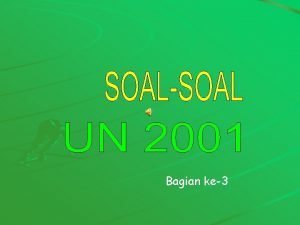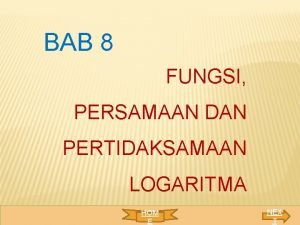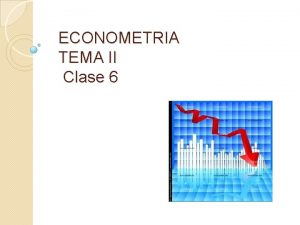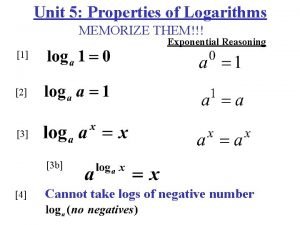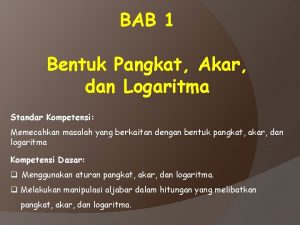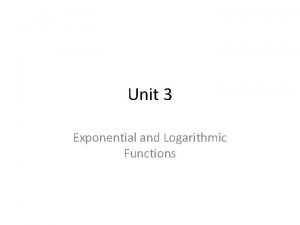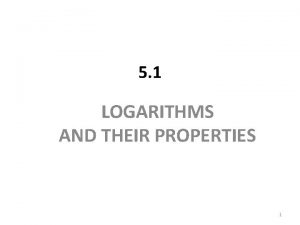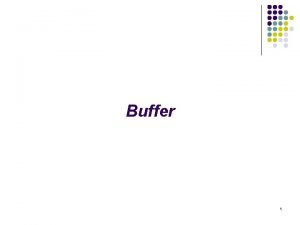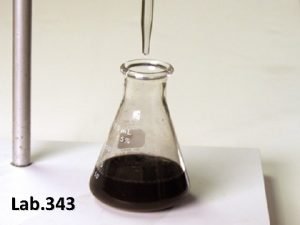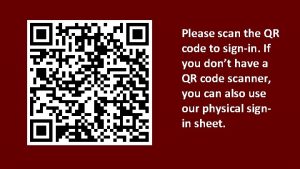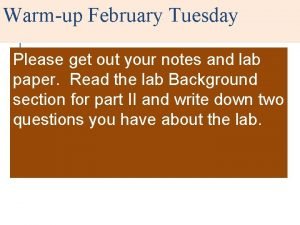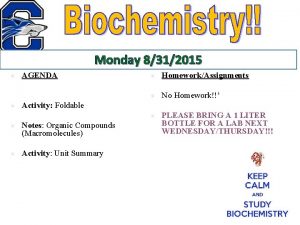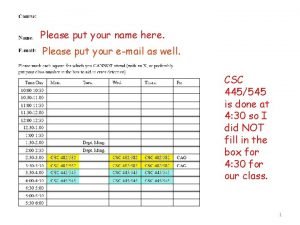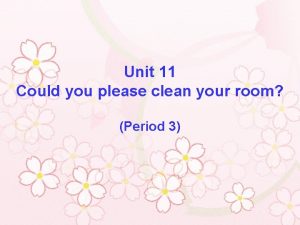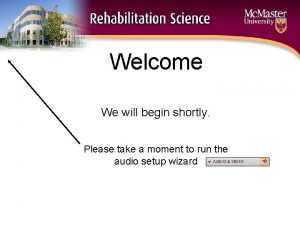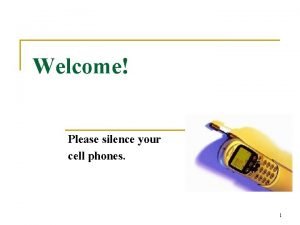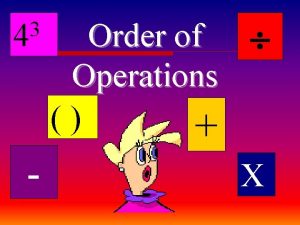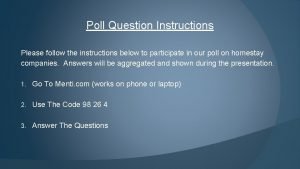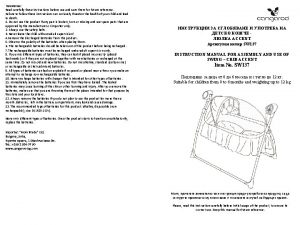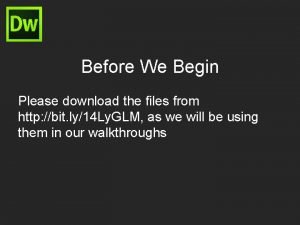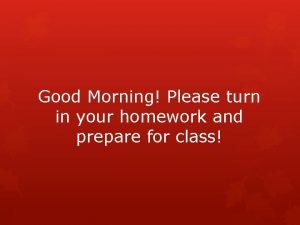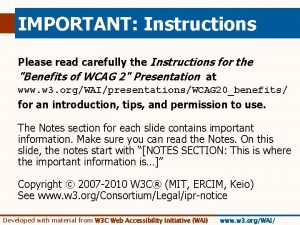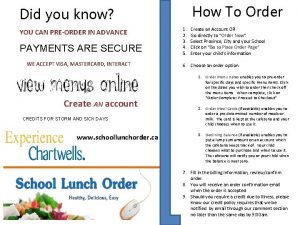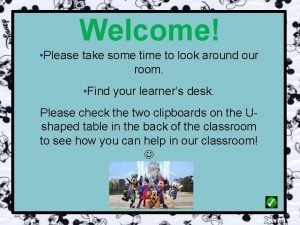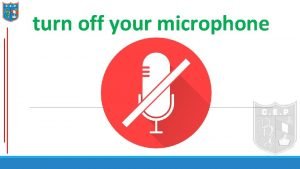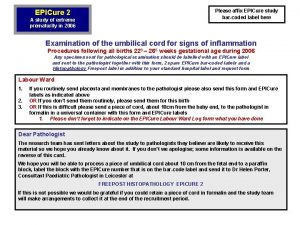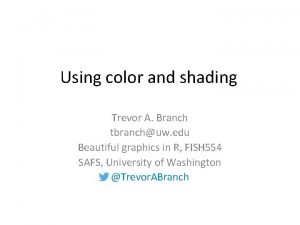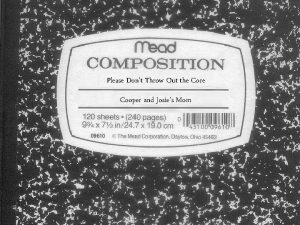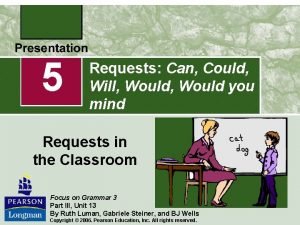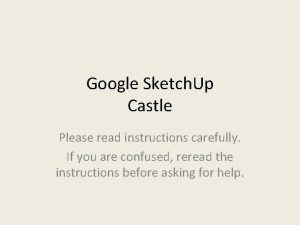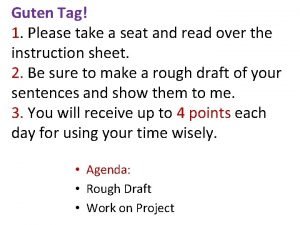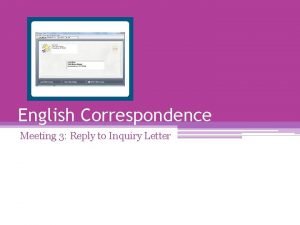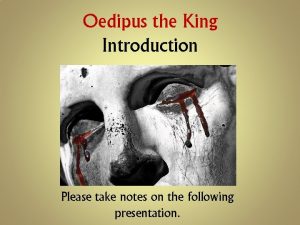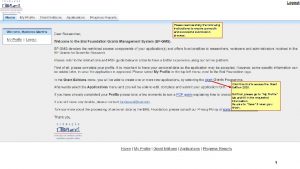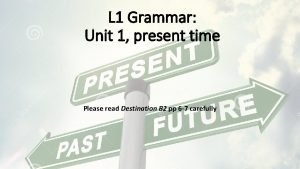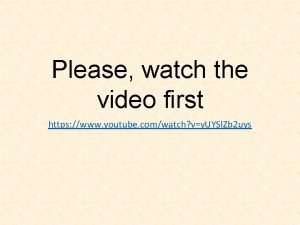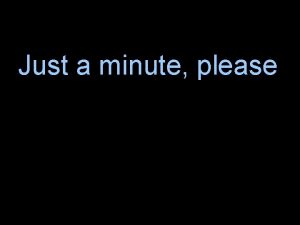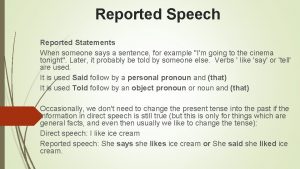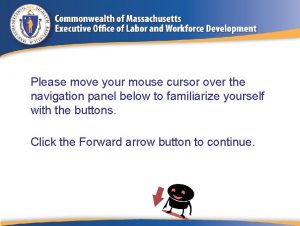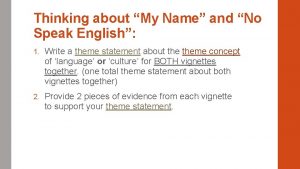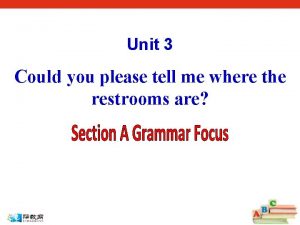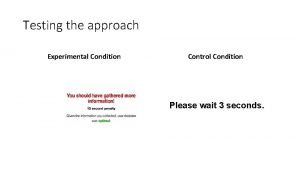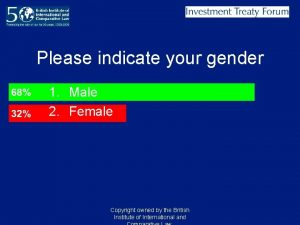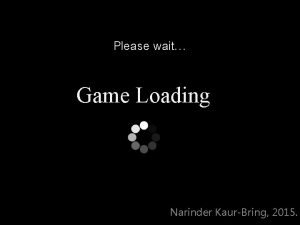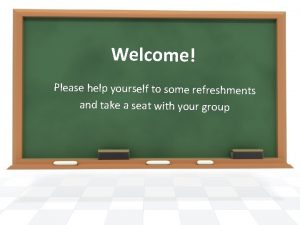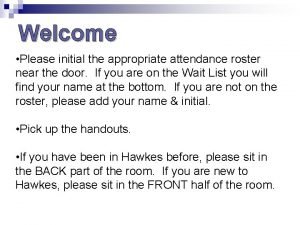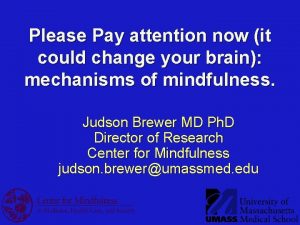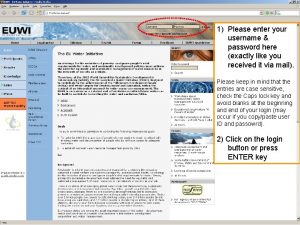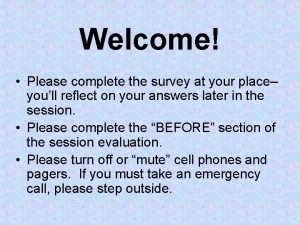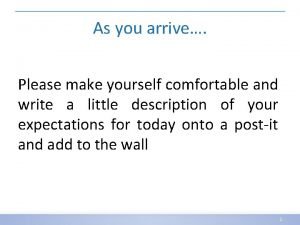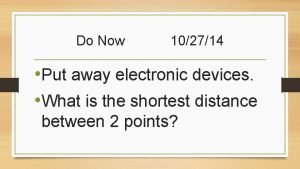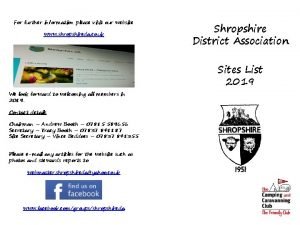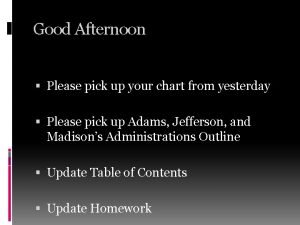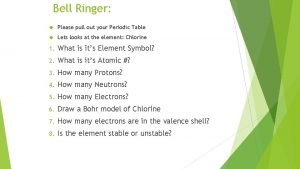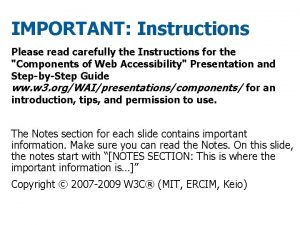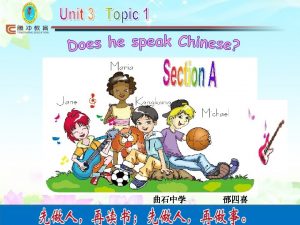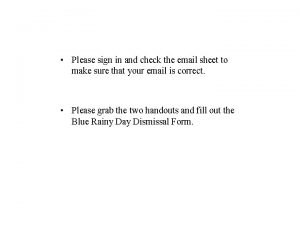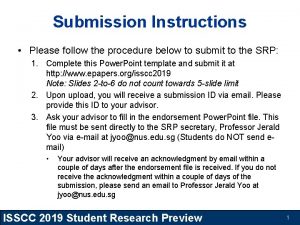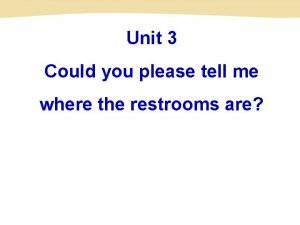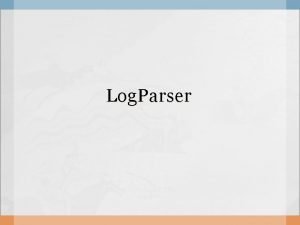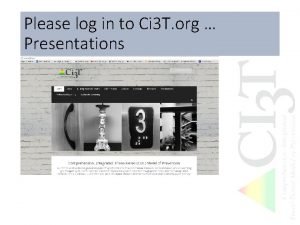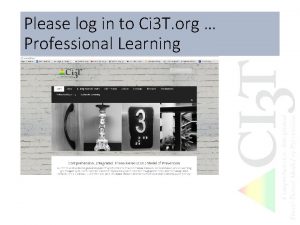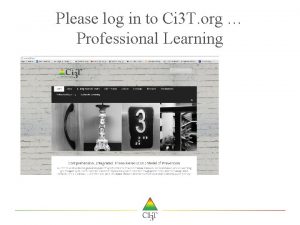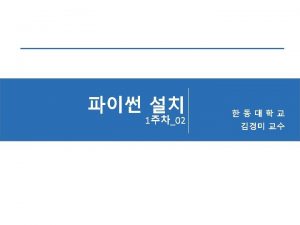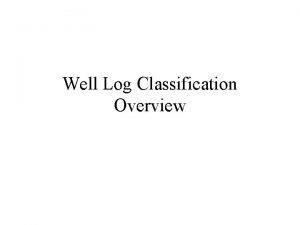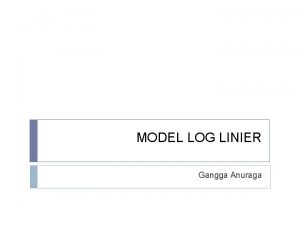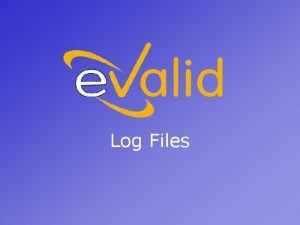Please log in to Ci 3 T org

























































































































- Slides: 121

Please log in to Ci 3 T. org … Professional Learning

Supporting Behavior for School Success: Teacher Level Strategies to Manage Behavior and Support Instruction, Part Two New York Kathleen Lynne Lane, Ph. D. , BCBA-D

Agenda • A look at Behavior Specific Praise • A look at Precorrection • A look at Active Supervision • A look at Instructional Feedback

Thank you… For Your Commitment to ALL Students • Students with emotional and behavioral disorders (EBD) represent a diverse and challenging group of students to teach (Forness, Freeman, Paparella, Kauffman, & Walker, 2011) • Historically as a field we have Internalizing • viewed behavioral and social challenges to be within individual deficits (Landrum & Tankersley, 2013) • relied on reactive approaches to address these challenges tems s y (Horner & Sugai, 2015) s e oa t v Shift erspecti p level Externalizing ED <1% EBD 12 -20%

Michael Yudin urged educators and educational system leaders to “pay as much attention to students’ social and behavioral needs as we do academics…” 2014 National PBIS Leadership Conference, Michael Yudin, Assistant Secretary for the Office of Special Education and Rehabilitation of the United States Department of Education

Working collaboratively to support learning for all students

A systems-based approach: Comprehensive, Integrated, Three-Tiered (Ci 3 T) Models of Prevention


r o f s e r u d e c o r P : n a l P ) 1 r e i T ( y r a Ci 3 T Prim Teaching Ci 3 T Prim ary (Tier 1 ) Plan: Pro cedures for Reinforcin g r o f s e r u d e c o r P : n a l P ) 1 r e i T ( y r a m i r P Ci 3 T Monitoring

Comprehensive, Integrated, Three-Tiered Model of Prevention (Lane, Kalberg, & Menzies, 2009) ≈5% Tertiary Prevention (Tier 3) ≈15% Secondary Prevention (Tier 2) Secondary (Tier 2) Intervention Grids ≈80% Primary Prevention (Tier 1) Academic Behavioral Social

Comprehensive, Integrated, Three-Tiered Model of Prevention (Lane, Kalberg, & Menzies, 2009) ≈5% Tertiary Prevention (Tier 3) Tertiary (Tier 3) Intervention Grids ≈15% Secondary Prevention (Tier 2) ≈80% Primary Prevention (Tier 1) Academic Behavioral Social

Transparency and Access Benefits of Ci 3 T Models

A Focus on Teacher. Level Strategies


Schoolwide Positive Behavioral Interventions and Supports Comprehensive, Integrated, Three-Tiered (Ci 3 T) Models of Prevention Low-Intensity Strategies Basic Classroom Management Effective Instruction Low-Intensity Strategies Behavior Contracts Self-Monitoring -Functional Assessment-Based Interventions Higher-Intensity Strategies Adapted from Lane, K. L. , Menzies, H. M. , Bruhn, A. L. , & Crnobori, M. (2011). Managing challenging behaviors in schools: Research-based strategies that work. New York, NY: Guilford Press. Assess, Design, Implement, and Evaluate Assessment

Low-Intensity Strategies for Academics and Behavior Opportunities to Respond Behavior-Specific Praise Active Supervision Instructional Feedback High p Requests Precorrection Incorporating Choice Lane, K. L. , Menzies, H. M. , Ennis, R. P. , & Oakes, W. P. (2015). Supporting behavior for school success: A step-by-step guide to key strategies. New York, NY: Guildford Press.

ci 3 t. org

Ci 3 T. org ci 3 t. org Professional Learning tab

Monitoring Progress Treatment Integrity Is it happening? Social Validity What do stakeholders think about the goals, procedures, and outcomes? Experimental Design How well did this support work for this student?

Explore “Professional Learning” on ci 3 t. org. • A look at Behavior Specific Praise • A look at Precorrection • A look at Active Supervision • A look at Instructional Feedback

Low-Intensity Strategies: Using Behavior Specific Praise to Support Instruction

Low-Intensity Strategies for Academics and Behavior Opportunities to Respond Behavior Specific Praise Active Supervision Instructional Feedback High p Requests Precorrection Incorporating Choice Self-monitoring Behavior Contracts

Agenda • • • What is behavior specific praise (BSP)? Why is BSP effective? What does the supporting research for BSP say? What are the benefits and challenges? How do I implement behavior specific praise in my classroom? Checklist for Success • How well is it working? Examining the Effects

Comprehensive, Integrated, Three-Tiered Model of Prevention (Lane, Kalberg, & Menzies, 2009) Goal: Reduce Harm Specialized individual systems for students with high-risk Tertiary ≈5% Prevention (Tier 3) ≈15% Secondary Prevention (Tier 2) Goal: Prevent Harm School/classroom-wide systems for all students, staff, & settings Goal: Reverse Harm Specialized group systems for students at-risk PBIS Framework ≈80% Validated Curricula Primary Prevention (Tier 1) Academic Behavioral Social

Schoolwide Positive Behavior Support Comprehensive, Integrative, Three-tiered (CI 3 T) Models of Support Low Intensity Strategies Basic Classroom Management Effective Instruction Low Intensity Strategies Behavior Contracts Self-Monitoring -Functional Assessment-Based Interventions Higher Intensity Strategies Assess, Design, Implement, and Evaluate Assessment

What is Behavior Specific Praise? • Behavior Specific Praise (BSP): Praise statements that include reference to the specific behavior for which the student is being recognized (Brophy, 1981; Sutherland, Wehby, & Copeland, 2000) • Key Components – Praise statement must be linked to a behavior – Provide feedback specific to the behavior – Be sincere – Reflect skill level – Evaluate effectiveness – Praise effort – not ability General v. Specific (Haydon, Musti-Rao, 2011, p. 31)

Examples • “Bob, great job showing your work on your math homework. ” • “I appreciate how you pushed in your chair on the way to line up for lunch. That keeps the walkways safe. ” BSP is a form of positive reinforcement

Why is Behavior Specific Praise effective? • More effective when – it is behavior specific rather than general praise – teachers use strategies to intentionally increase their rate of BSP IFEED-AV and target their delivery of BSP to identified students (Thompson, Immediately, Marchant, Anderson, Prater, & Gibb, 2012). • • Frequently, Enthusiasm, Simple, effective, requires minimal effort Instructional feedback delivered at a Eye rate. Contact, of four positive to one negative (4: 1 ratio; Myers, Simonsen, & Sugai, 2011) Describe, Most effective when delivered consistently and Anticipation, immediately after desired behavior Variety Establishes supportive and positive classroom (Rhode, Jenson, & Reavis, 1992) environment (Marchant & Anderson, 2012; Kennedy & Jolivette, 2008 ; Stormont & Reinke, 2009)

What does the supporting research for BSP say? • Increasing preschool student’s on-task behavior during transitions in inclusion classrooms (Fullerton, Conroy, & Correa, 2009) • Increasing teachers’ use of behavior specific praise in self-contained classrooms (Hawkins & Helfin, 2011) • Increasing time spent inside the classroom in a residential facility (Kennedy & Jolivette, 2008)

Supporting Research See “Behavior Specific Praise Resource Guide” for additional supporting research and information.

What are the benefits and challenges? Benefits Challenges • Takes little effort and costs nothing • Improves student- teacher relationships • Not time consuming or intrusive • Increases on-task behavior and reduces problem behavior • Increases positive social and academic behaviors • Determine students’ preferred method of praise – public or private • Consider the needs of students who are motivated by escaping tasks or activities rather than accessing teacher attention (Lampi, Fenty, & Beaunae, 2005; Marchant & Anderson, 2012; Stormont & Reinke, 2009)

How do I implement behavior specific praise in my classroom? Checklist for Success Step 1 Evaluate current rates of general and behavior specific praise. Step 2 Identify behaviors to reinforce. Step 3 Practice delivery of BSP. Step 4 Observe student behavior.

How do I implement behavior specific praise in my classroom? Checklist for Success Step 5 Provide BSP. Step 6 Monitor BSP delivery. Step 7 Seek student input.

How do I increase BSP in my classroom? Checklist for Success • Step 1: Evaluate current rates of general and behavior specific praise • Step 2: Identify behaviors to reinforce • Step 3: Practice delivery of BSP • Step 4: Observe student behavior • Step 5: Provide BSP • Step 6: Monitor BSP delivery • Step 7: Seek student input See “Behavior Specific Praise Implementation Checklist for Success”

How well is it working? Examining the Effects Treatment Integrity Is it happening? Social Validity What do stakeholder s think about the goals, procedures, and outcomes? Experimental Design How well did this support work for this student? 2014 -2015 CI 3 T Training Project 35

Ensuring the Strategy is in Place: Treatment Integrity Have structures in place to monitor whether behavior specific praise is carried out as intended. Treatment integrity checklist items: 1. Did I identify target behaviors and/or students to acknowledge using BSP? 2. Did I prepare to deliver BSP prior to the lesson (i. e. , scripts complete, deliver practiced, additional reinforcers gathered)? 3. Did I observe students for the target behavior (or a portion / approximation thereof)? 4. Did I provide a praise statement that acknowledged a specific target behavior and was administered immediately following the target behavior? 5. Did I self-monitor my use of BSP? See “Behavior Specific Praise Treatment Integrity Checklist”

What does the student think about it? See “Behavior Specific Praise Social Validity Student” Completed by the student(s) participating in the intervention at two time points: Pre and Post Intervention

What does the teacher think about it? See “Social Validity Adapted. IRP 15 Adult” Completed by the teacher(s) and parent(s) involved in the intervention at two time points: Pr e a n d Po s t Intervention

Sample Elementary Intervention Grid Support Description Behavior specific praise (BSP) refers to sincere praise statements that acknowledge the student and reference specific, desirable behavior being recognized, praising effort (not ability). School-wide Data: Entry Criteria One or more of the following: Behavior: SRSS-E 7: Moderate (4 -8) SRSS-I 5: Moderate (2 -3) SRSS-E 7: High (9 -21) SRSS-I 5: High (4 -15) Ranking of 1, 2, or 3 on the Motivation to Learn subscale of SSi. S-PSG 2 or more ODRs within a grading period AND/OR Academic: Two of more missing assignments within a grading period AIMSweb: intensive or strategic level (math or reading) Progress report: Targeted for Growth for academic learning behaviors Data to Monitor Exit Criteria Progress Student behavior 0 -1 ODRs in a targeted for grading improvement (e. g. , period academic engaged and time % of intervals, Zero missing assignments completion, ODRs). in a grading period Treatment and integrity Implementation SRSS-E 7: Low (0 -3) checklist SRSS-I 5: Low Treatment (0 -1) integrity or checklist Ranking of 4 Social validity or 5 on the IRP-15 (teacher) Motivation to Student. Learn subscale completed of SSi. S-PSG survey (Lane, Menzies, Ennis, & Oakes, 2015)

Sample Secondary Intervention Grid Support Description Behavior specific praise (BSP) refers to sincere praise statements that acknowledge the student and reference specific, desirable behavior being recognized, praising effort (not ability). School-wide Data: Entry Criteria One of more of the following: Behavior: SRSS: Moderate (4 -8) SRSS: High (9 -21) Ranking of 1, 2, or 3 on the Motivation to Learn subscale of the SSi. S-PSG 2 office discipline referrals (ODRs) within a grading period AND/OR Academic: Report card: 1 or more course failures Two of more missing assignments within a grading period in a class AIMSweb: intensive or strategic level (math or reading) Below 2. 5 GPA Data to Monitor Exit Criteria Progress Student behavior 0 -1 ODRs in a targeted for grading period improvement (e. g. , and academic engaged 2. 5 GPA or time % of intervals, higher assignment Zero missing completion, ODRs). assignments per class in a Treatment grading integrity period Implementation and checklist SRSS: Low (0 Treatment 3) integrity or checklist Ranking of 4 Social validity or 5 on the IRP-15 (teacher) Motivation to Student. Learn subscale completed of the SSi. Ssurvey PSG (Lane, Menzies, Ennis, & Oakes, 2015)

CI 3 T Ticket Examples

Will you please …. Draft a list of behavior specific praise statements you can use … • In your classroom during various instructional activities. • In other key areas in your building (see expectation matrices). • Encourage the use of skills taught during your school-wide social skills program. Plan … Implementation Checklist for Success: BSP Let’s talk …

Will you please …. Plan … Implementation Checklist for Success: Behavior Specific praise

Low Intensity Strategies: A Look at Precorrection

Comprehensive, Integrated, Three-Tiered Model of Prevention (Lane, Kalberg, & Menzies, 2009) Goal: Reduce Harm Specialized individual systems for students with high-risk Tertiary ≈5% Prevention (Tier 3) ≈15% Secondary Prevention (Tier 2) Goal: Prevent Harm School/classroom-wide systems for all students, staff, & settings Goal: Reverse Harm Specialized group systems for students at-risk PBIS Framework ≈80% Validated Curricula Primary Prevention (Tier 1) Academic Behavioral Social

Schoolwide Positive Behavior Support Comprehensive, Integrative, Three-tiered (CI 3 T) Models of Support Low Intensity Strategies Basic Classroom Management Effective Instruction Low Intensity Strategies Behavior Contracts Self-Monitoring -Functional Assessment-Based Interventions Higher Intensity Strategies Assess, Design, Implement, and Evaluate Assessment

Low-Intensity Strategies for Academics and Behavior Opportunities to Respond Behavior Specific Praise Active Supervision Instructional Feedback High p Requests Precorrection Incorporating Choice Self-monitoring Behavior Contracts

Agenda • What is a precorrection? • Why is precorrection effective? • What does the supporting research for precorrection say? • What are the benefits and challenges? • How do I implement precorrection in my classroom? • Checklist for Success • How well is it working? Examining the Effects

What is a Precorrection? A B C Antecedent Behavior Consequence Identifies predictable contexts that often result in problem behavior and provides students with supports, prompts, and reinforcement for engaging in appropriate behavior

What is a Precorrection? Managing behavior with precorrection: Managing behavior with consequences: • Anticipate what activities may cause inappropriate behaviors • “Getting in front” of problem behaviors • Example: Gentle reminder of expected behaviors in the hallway before dismissing for lunch • Requires waiting until the behavior occurs to respond • Example: Creating an action plan for three alternatives to yelling at a peer vs.

Seven-step precorrection strategy (Colvin, Sugai, & Patching, 1993) Identify the context and predictably challenging behaviors Define the expected behavior Modify the context to support student success Provide students with an opportunity to practice the expected behavior Provide students with strong reinforcement for completing the expected behavior Create a prompting plan to remind students to engage in the expected behavior Develop a monitoring plan to determine the effectiveness of the precorrection plan

Examples

Examples • “It’s almost time to walk down to PE – who can remind us of one way we show RESPECT in the hallway? ” • “In order to line up for lunch, raise your hand if you can tell us one way to be RESPONSIBLE in the cafeteria? ”

Why is Precorrection Effective? Where might students currently have challenges? Precorrection: Get in front of problem behavior! • Manipulation of antecedents and consequences • Anticipates activities, settings, or time of day that could potentially result in problem behavior • Proactive • Focuses on what students should do instead of problem behaviors • Prevents the potential for escalating behavior patterns and allows more time for positive student-teacher interactions (Colvin et al, 1993)

Why is Precorrection Effective? • Fits seamlessly in a Ci 3 T framework – Proactive strategy that seeks to teach, monitor, and reinforce appropriate behavior – Used to teach behavioral expectations for common areas in the building where problem behaviors occur (e. g. lunchroom) – May be used as a Tier 2 intervention • Target a group of students

What does the supporting research for precorrection say? • Decreasing problem behaviors in Head Start classrooms – Stormont, Smith, & Lewis, 2007 • Decreasing problem behavior on an elementary school playground – Lewis, Colvin, & Sugai, 2000 • Decreasing problem behaviors during morning gym – Haydon & Scott, 2008

Supporting Research See “Precorrection Resource Guide” for additional supporting research and information.

What are the benefits and challenges? Benefits Challenges • Making contextual • Shift in thinking changes to • Need to reflect on daily activities/settings that schedule and routines traditionally occasion to anticipate when problem behaviors may • Proactive arise • Varying levels of • Must have some intensity knowledge of a given setting

How do I implement a precorrection in my classroom? Checklist for Success Step 1 Identify contexts and anticipated behaviors Step 2 Determine the expected behaviors Step 3 Adjust the environment Step 4 Provide opportunities for behavioral rehearsal

How do I implement a precorrection in my classroom? Checklist for Success Step 5 Provide strong reinforcement to students engaging in expected behaviors Step 6 Develop a prompting plan to remind students about the expected behavior Step 7 Develop a monitoring plan to determine the effectiveness of the precorrection plan Step 8 Offer students an opportunity to give feedback on this strategy

How do I implement precorrection in my classroom? 1. 2. 3. 4. 5. 6. 7. 8. Identify context and anticipated behaviors. Determine the expected behaviors. Adjust the environment. Provide opportunities for behavioral rehearsal. Provide strong reinforcement to students engaging in expected behavior. Develop a prompting plan to remind students about the expected behavior. Develop a monitoring plan to determine the effectiveness of the precorrection plan. Offer students an opportunity to give feedback on this strategy. See “Precorrection Implementation Checklist for Success”

How well is it working? Examining the Effects Treatment Integrity Is it happening? Social Validity What do stakeholders think about the goals, procedures, and outcomes? Experimental Design How well did this support work for this student? 2014 -2015 CI 3 T Training Project 62

Ensuring the Strategy is in Place: Treatment Integrity Have structures in place to monitor whether precorrection is carried out as intended: Treatment integrity checklist Example items: 1. Did I identify the context and determine the expected behavior? 2. Did I modify the environment to promote student success? 3. Did I provide students with an opportunity to practice the expected behavior? 4. Did I provide students with strong reinforcement for completing the expected behavior? 5. Did I prompt students to remind them to engage in the expected behavior? 6. Did I monitor student behavior? See “Precorrection Treatment Integrity Checklist”

What do students think about it? See “Precorrection Social Validity Student” Completed by the student(s) participating in the intervention at two time points: Pre and Post Intervention

What does the teacher think about it? See “Social Validity Adapted. IRP 15 Adult” Completed by the teacher(s) and parent(s) involved in the intervention at two time points: Pr e a n d Po s t Intervention

Comprehensive, Integrated, Three-Tiered Model of Prevention (Lane, Kalberg, & Menzies, 2009) Goal: Reduce Harm Specialized individual systems for students with high-risk Tertiary ≈5% Prevention (Tier 3) ≈15% Secondary Prevention (Tier 2) Goal: Prevent Harm School/classroom-wide systems for all students, staff, & settings Goal: Reverse Harm Specialized group systems for students at-risk PBIS Framework ≈80% Validated Curricula Primary Prevention (Tier 1) Academic Behavioral Social

Sample Elementary Intervention Grid Support Description Precorrection Plan to modify teacher behavior and environmental contexts where problem behaviors are likely to occur by providing supports, prompts, and reinforcement for appropriate student behavior, preventing problem behaviors from occurring School-Wide Data: Entry Criteria One or more of the following: Behavior SRSS-E 7: Moderate (4 -8) SRSS-I 5: Moderate (2 -3) SRSS-E 7: High (9 -21) SRSS-I 5: High (4 -15) 2 or more ODRs per day in a class __ AND __ OR Academic Consistent, predictable pattern of academic errors Data to Monitor Progress Student Performance • direct measure of student behavior targeted for improvement Treatment integrity • implementation checklist • treatment integrity checklist Social validity • IRP-15 (teacher) • student-completed survey Exit Criteria Meets targeted behavior criterion for 3 consecutive weeks Two consecutive weeks of zero discipline referrals during target time / activity and q SRSS-E 7: low risk (0 -3) q SRSS-I 5: low risk (0 -1) (Lane, Menzies, Ennis, & Oakes, 2015)

Sample Middle/High School Intervention Grid Support Precorrection Description School-Wide Data: Entry Criteria Plan to modify One or more of the teacher behavior following: and environmental Behavior SRSS-E 7: Moderate contexts where (4 -8) problem behaviors are likely to occur SRSS-E 7: High (9 -21) 2 or more ODRs per by providing day in a class supports, prompts, and reinforcement __ AND __ OR for appropriate student behavior, Academic preventing Consistent, problem behaviors predictable pattern from occurring of academic errors Data to Monitor Progress Student Performance • direct measure of student behavior targeted for improvement Treatment integrity • implementation checklist • treatment integrity checklist Social validity • IRP-15 (teacher) • student-completed survey Exit Criteria Meets targeted behavior criterion for 3 consecutive weeks Two consecutive weeks of zero discipline referrals during target time / activity and SRSS-E 7: low risk (0 -3) (Lane, Menzies, Ennis, & Oakes, 2015)

Expanding Your Tool Kit

MTSS: CI 3 T Training Series Overview of Teacher focused Strategies Overview of Student Focused Strategies Using data to determine Draft the Secondary Intervention Grid based on existing supports Session 4: Revise Primary Plan using Stakeholder feedback Prepare presentation Additional Professional Development on Specific Topics tation n e m Imple f Tier 2 o Stages hin CI 3 T wit and 3 Session 6: Final revisions of CI 3 T Plan based on stakeholder feedback Draft Tertiary Prevention Intervention Grids Design Implementation Manual and Plan for roll out to faculty, students, and parents CI 3 T: Tertiary Prevention Session 5: CI 3 T: Secondary Prevention Overview of CI 3 T Prevention Models Setting a Purpose Establish team meetings and roles Session 2: Mission and Purpose Establish Roles and Responsibilities Procedures for Teaching Procedures for Reinforcing Reactive Plan Session 3: Procedures for Monitoring CI 3 T: Primary Prevention CI 3 T Team Training Sequence Session 1: Core Content Curriculum Check In - Check Out Functional Assessmentbased Interventions Reading, Math, Writing Benchmarking and Progress Monitoring Tools Student Driven Interventions, Strategies, & Practices Additional Tier 3 Supports Teacher Driven Supports: Instructional Techniques to Improve Students’ Motivation; General Classroom Management Practices; Low-Intensity Behavior Supports

Will you please …. Plan … Implementation Checklist for Success: Precorrection

Low-Intensity Strategies: Using Active Supervision to Support Instruction

Agenda • Comprehensive, Integrated, Three-Tiered (CI 3 T) Models of Prevention • A Look at Active Supervision – What is active supervision? – Why is active supervision effective? – What does the supporting research for active supervision say? – What are the benefits and challenges? – How do I active supervision in my classroom? Checklist for Success – How well is it working? Examining the Effects

What is active supervision? Use of “Specific and overt behaviors (scanning, escorting, interacting) designed to prevention problem behavior and promote rule-following behavior”(Colvin, Sugai, Good, & Lee, 1997, p. 346). Effectiveness is increased when used with precorrections. (Lane, Menzies, Ennis, & Oakes, 2015) Distinct Elements (De Pry & Sugai, 2002; Haydon & Scott, 2008): • Established expectations • Frequent scanning of context • Positive interactions (verbal and nonverbal precorrections and prompts) • Reinforcement of desired behavior • When necessary, correction to help success

What is active supervision? See “AS Introduction”

Why is active supervision effective? • Proactive: It is more efficient to preventing problems from occurring or escalating than addressing after they occurred (Colvin, 2004) • Provides routines and structures to avoid problem behavior caused by overcrowding and impersonalized learning (Jackson, 1990). • Systematically averts challenges while using prompting prosocial behaviors- PBIS (Sugai & Horner, 2006) (Lane, Menzies, Ennis, & Oakes, 2015)

What does the supporting research for active supervision say? • Reduces high rates of minor classroom behavior (De Pry & Sugai, 2002) • Increases time spent learning in middle school (Haydon, De. Greg, Maheady, & Hunter, 2012) • Improving behaviors during transition (Colvin, Sugai, Good, & Lee, 1997) • Reduces tardiness to class in middle and high school (Tyre, Feuerborn, & Pierce, 2011)

Supporting Research See “AS Resource Guide” for additional supporting research and information.

What are the benefits and challenges? Benefits • Reduces problem behavior in multiple school contexts • Improves times spent on -task • Can target specific behaviors • Essential part of school safety • Proactive (Lane, Menzies, Ennis, & Oakes, 2015) Challenges • Performing consistently is difficult • Requires some innate ability to monitor student activity • Requires prerequisite familiarity and fluency of precorrection, prompting, and reinforcement

How do I implement active supervision in my classroom? Step 1 Identify the activity or transition period that would benefit most from active supervision. Step 2 Ensure that the routine for the target activity is familiar and understood by students. If not, routines and expectations must be established. Step 3 Provide the cue or prompt to begin the activity. Step 4 As the activity unfolds, scan and monitor the area. (Lane, Menzies, Ennis, & Oakes, 2015)

How do I implement active supervision in my classroom? Step 5 Signal your awareness of students’ actions through proximity, prompts, and non- verbal communication. Step 6 Manage infractions and off-task behavior efficiently: privately, businesslike, and with opportunities for positive interactions. Step 7 At appropriate intervals and at the end of the activity or transition, reinforce students’ good behavior with positive comments and gestures. Step 8 Provide the students with an opportunity to give feedback. (Lane, Menzies, Ennis, & Oakes, 2015)

How do I increase Active Supervision in my classroom? Checklist for Success See “AS Implementation Checklist” (Lane, Menzies, Ennis, & Oakes, 2015)

How well is it working? Examining the Effects Treatment Integrity Is it happening? Social Validity What do stakeholders think about the goals, procedures, and outcomes? Experimental Design How well did this support work for this student?

Ensuring the Strategy is in Place: Treatment Integrity See “AS Treatment Integrity Checklist”

Social Validity: What does the student think about it? See “AS Social Validity Student Survey” for Pre and Post Completed by the student(s) participating in the intervention at two time points: Pre and Post Intervention

Social Validity: What does the teacher think about it? See “Social Validity Adapted. IRP 15 Adult” for Pre and Post Completed by the teacher and/or parent participating in the intervention at two time points: pre and post intervention

Sample Elementary Grid Illustration Support Active Supervision Description The use of “specific and overt behaviors (scanning, escorting, interacting) designed to prevent problem behavior and promote rulefollowing behavior” (Colvin et al. , 1997, p. 346). Teacher may create behavior specific implementation plan in which the following distinct elements are incorporated (De Pry & Sugai, 2002; Haydon & Scott, 2008): • • • Established expectations Frequent scanning of context Positive interactions (verbal and nonverbal precorrections and prompts) Reinforcement of desired behavior When necessary, correction to help success. School-wide Data: Entry Criteria Data to Monitor Progress One or more of the following: Student Performance Examples: Data on target Percentage of students late to behavior class at the onset of the school monitored day exceeding 10% during a 2 On time arrival week period On task Time to 3+ ODRs earned during lunch for a 2 week period transition More than 20% of students in a class are off task during center time for a 1 week period of time More than 20% of students in a class exceed allotted time for transitions Treatment Integrity Component checklist Social Validity Student- and teachercompleted surveys Exit Criteria No planned exit criteria; New procedure to remain in place for the balance of the school year

Sample Middle/ High Grid Illustration Support Active Supervision Description School-wide Data: Entry Criteria The use of “specific and overt behaviors (scanning, escorting, interacting) designed to prevent problem behavior and promote rulefollowing behavior” (Colvin et al. , 1997, p. 346). Teacher may create behavior specific implementation plan in which the following distinct elements are incorporated (De Pry & Sugai, 2002; Haydon & Scott, 2008): Examples: Percentage of students late to first period exceeding 10% during a 2 week period • • • More than 20% of students in a class are off task during group activities for a 1 week period of time Established expectations Frequent scanning of context Positive interactions (verbal and nonverbal precorrections and prompts) • Reinforcement of desired behavior When necessary, correction to help success. One or more of the following: 5+ ODRs earned during lunch for a 2 week period More than 20% of students in the school tardy to one or more periods for a 1 week period of time Data to Monitor Progress Exit Criteria Student Performance Data on target behavior monitored On time arrival On task Tardies No planned exit criteria; New procedure to remain in place for the balance of the school year Treatment Integrity Component checklist Social Validity Student- and teacher -completed surveys

Low-Intensity Strategies for Academics and Behavior Opportunities to Respond Behavior Specific Praise Active Supervision Instructional Feedback High p Requests Precorrection Incorporating Choice Self-monitoring Behavior Contracts

Will you please …. Plan … Implementation Checklist for Success: Active Supervision

Low-Intensity Strategies: Using Instructional Feedback to Support Instruction

Low-Intensity Strategies for Academics and Behavior Opportunities to Respond Behavior Specific Praise Active Supervision Instructional Feedback High p Requests Precorrection Incorporating Choice Self-Monitoring Behavior Contracts

Agenda • What is instructional feedback? • Why is instructional feedback effective? • What does the supporting research for instructional feedback say? • What are the benefits and challenges? • How do I implement instructional feedback in my classroom? Checklist for Success • How well is it working? Examining the Effects

Comprehensive, Integrated, Three-Tiered Model of Prevention (Lane, Kalberg, & Menzies, 2009) Goal: Reduce Harm Specialized individual systems for students with high-risk Tertiary ≈5% Prevention (Tier 3) ≈15% Secondary Prevention (Tier 2) Goal: Prevent Harm School/classroom-wide systems for all students, staff, & settings Goal: Reverse Harm Specialized group systems for students at-risk PBIS Framework ≈80% Validated Curricula Primary Prevention (Tier 1) Academic Behavioral Social

Schoolwide Positive Behavior Support Comprehensive, Integrative, Three-tiered (CI 3 T) Models of Support Low Intensity Strategies Basic Classroom Management Effective Instruction Low Intensity Strategies Behavior Contracts Self-Monitoring -Functional Assessment-Based Interventions Higher Intensity Strategies Assess, Design, Implement, and Evaluate Assessment

CI 3 T Primary Plan Social Academics Behavior

What is instructional feedback? • Teaching strategy to: – Clarify misinformation – Confirm understandings – Fine-tune understandings – Restructure current schemas • Produces learning by delivering content related information and reinforcement that positively affects motivation effort engagement (Butler & Winne, 1995; Kulhavy & Wagner, 1993)

What is instructional feedback? • Used when students – have base of understanding – working toward proficiency and fluency • Two-fold Function – Teachers gain students’ perception of instructions • adjust instructional planning – Students benefit from positive specific feedback • increase intrinsic motivation (Deci & Ryan, 2000) • increase persistence on future difficult tasks (Kamins & Dweck, 1999)

The Learning Process Cues Feedback and/or Reinforcement Participation (Heward, 1994; Lysakowski & Walberg, 1982; Miller & Dollard, 1941)

Purpose • To close the gap between expected and current performance in academics, behavior, and social skills (Hattie, 2009) • The learner must have an opportunity to engage in an action in response to the feedback (Gable, Hester, Rock, & Hughes, 2009)

Feedback Model Where am I going? What are the goals? How am I going? What progress is being made toward the goals? Where do I go next? What activities need to be undertaken to make better progress? Hattie and Timperley (2007) • Effective instructional feedback provides information on the learning process and content acquisition instead of the correct response

Examples How am I going? “Jorge, you are using the 4 -step process we learned to accurately complete the problem. ” Where do I go next? “Celia, please write the acronym for the 4 -step process next to the problem and cross off each step as you complete it. That will help you keep the order of the steps. ” – Error Correction “Celia, using the mnemonic helped you apply the process to solve the problem accurately. ” Provide feedback on malleable characteristics such as effort. “You included all of the elements of the essay; you did a good job using the rubric to write your paper”

Why is Instructional Feedback Effective? • Serves as a motivator and reinforcer • Provides instructional information – Cues students to focus on key processes, information, and concepts (Butler & Winne, 1995) – Specific and offers support to correct content and misunderstandings (Harks et al. , 2014) • Positive, proactive approach for correcting learning errors • Increases motivation (Kamins & Dweck, 1999) • Supports intrinsic motivation

Why is Instructional Feedback Effective? • Feedback should be related to – effort and actions that are malleable, not based upon ability – a criterion or the individual’s previous performance • Negative effects occur when students are compared to peers (Harks et al. , 2014) – Critical feedback creates doubt, lowers selfconfidence, and lowers motivation to attempt difficult tasks – Particularly true for students with EBD and LD (Alber, Heward, & Hippler, 1999)

What does the supporting research for instructional feedback say? • Increased on-task behavior for students with EBD in the general education classroom (Allday et al. , 2012) • Improve students’ math outcomes with use of strategy feedback (process) and outcome feedback (accuracy of response) working memory mediated the outcomes (Fyfe, De. Caro, & Rittle-Johnson, 2015) • Instructional feedback related to schoolwide expectations resulted in reductions in behavioral incidents over two years (Simonsen, Britton, & Young, 2010)

Supporting Research See “Instructional Feedback Resource Guide” for additional supporting research and information.

What are the benefits and challenges? Benefits Challenges • • • Determining the best type of feedback • Carefully selecting words to use Large group Targeted small group Minimal time Creates safe learning environment • Supports students in demonstrating expected behaviors • Improves academic outcomes • Increases engagement – Students may perceive feedback as critical if care is not taken • Measuring the effectiveness of feedback

How do I implement instructional feedback in my classroom? Checklist for Success Step 1 Identify learning goals Step 2 Provide instruction to meet established goals Step 3 Provide clear directions and checks for understanding Step 4 Opportunities for practice and feedback are planned

How do I implement instructional feedback in my classroom? Checklist for Success Step 5 Implement active supervision and provide instructional feedback Step 6 Provide time and direction for students to review work or have additional opportunities to practice Step 7 Evaluate instructional practices Step 8 Offer students an opportunity to give feedback on how instructional feedback is being offered

How do I increase Instructional Feedback in my classroom? Implementation checklist for success • Step 1: Identify learning goals. • Step 2: Provide instruction to meet established goals. • Step 3: Provide clear directions and checks for understanding. • Step 4: Opportunities for practice and feedback are planned. • Step 5: Implement active supervision and provide instructional feedback. • Step 6: Provide time and direction for students to review work or have additional opportunities to practice. • Step 7: Evaluate instructional practices. • Step 8: Offer students an opportunity to give feedback on how instructional feedback is being offered. See “Instructional Feedback Implementation Checklist for Success”

How well is it working? Examining the Effects Treatment Integrity Is it happening? Social Validity What do stakeholders think about the goals, procedures, and outcomes? Experimental Design How well did this support work for this student?

Instructional Feedback Student Outcomes Panel B. Paola’s Academic Engagement and Spanish Assignment Accuracy Baseline A 1 Feedback B 1 Withdrawal A 2 Feedback B 2 AE T cy ra u c Ac Figure 5. 1 Examining the effects: Students’ academic engagement and assignment accuracy: Percentage during Spanish class. Hypothetical Illustration (Lane, Menzies, Ennis, & Oakes, 2015)

Ensuring the Strategy is in Place: Treatment Integrity Have structures in place to monitor whether instructional feedback is carried out as intended. Treatment integrity checklist items: 1. I identified and shared learning goals. 2. I provided instruction to meet the established goals. 3. I provided clear directions and checked for understanding. 4. Students had opportunities to practice. 5. I used active supervision and provided instructional feedback. 6. I provided time, direction for students to review work or have additional opportunities to practice. 7. I evaluated instruction based on student response. See “Instructional Feedback Treatment Integrity Checklist”

What does the student think about it? See “Instructional Feedback Social Validity Student” Completed by the student(s) participating in the intervention at two time points: Pre and Post Intervention

What does the teacher think about it? See “Social Validity Adapted. IRP 15 Adult” Completed by the teacher(s) and parent(s) involved in the intervention at two time points: Pr e a n d Po s t Intervention

Sample Elementary Intervention Grid Support Description School-wide Data: Entry Criteria Instructional Feedback Instructional feedback refers to detailed, specific information for students from a teacher or peer to confirm, finetune, clarify, and restructure current schemas. Verbal, written, or technology based specific feedback on processes and progress. One of more of the following: Behavior: SRSS-E 7: Moderate (4 -8) SRSS-I 5: Moderate (2 -3) SRSS-E 7: High (9 -21) SRSS-I 5: High (4 -15) Ranking of 1, 2, or 3 on the Motivation to Learn subscale of the SSi. S-PSG Two or more office discipline referrals (ODRs) within a grading period ___ AND ___ OR Academic: Three or more assignments scoring 79% or below within a grading period AIMSweb: intensive or strategic level (math or reading) Progress report: Targeted for Growth for academic learning behaviors Data to Monitor Progress Exit Criteria Student performance Zero missing targeted for assignments in a improvement (e. g. , grading period homework grades, quiz All assignments grades, test grades, % scoring 80% or of work completed, higher in a grading academic engaged period time % of intervals). and SRSS-E 7: Low (0 -3) Treatment integrity SRSS-I 5: Low (0 -1) Implementation or checklist Ranking of 4 or 5 Treatment on the Motivation integrity checklist to Learn subscale of SSi. S-PSG Social validity IRP-15 (teacher) Studentcompleted survey (Lane, Menzies, Ennis, & Oakes, 2015)

Sample Middle/High School Intervention Grid Support Description Instructional Feedback feedback refers to detailed, specific information for students from a teacher or peer to confirm, finetune, clarify, and restructure current schemas. Verbal, written, or technology based specific feedback on processes and progress. School-wide Data: Entry Criteria One of more of the following: Behavior: SRSS-E 7: Moderate (4 -8) SRSS-I 7: Moderate (cut scores coming soon) Data to Monitor Progress Exit Criteria Student performance Zero missing targeted for assignments in improvement (e. g. , target class(es) for homework grades, quiz a grading period grades, test grades, % 2. 5 GPA or higher in of work completed, a grading period academic engaged and time % of intervals). SRSS-E 7: Low (0 -3) SRSS-I 5: Low (0 -1) Treatment integrity or Implementation Ranking of 4 or 5 on checklist the Motivation to Treatment Learn subscale of integrity checklist SSi. S-PSG SRSS-E 7: High (9 -21) SRSS-I 7: High (cut scores coming soon) Ranking of 1, 2, or 3 on the Motivation to Learn subscale of the SSi. S-PSG Two or more office discipline referrals within a grading period ___ AND ___ OR Academic: Two or more missing assignments in any class Social validity Three or more assignments in any IRP-15 (teacher) class at C or below Student Progress report: Targeted for completed survey Growth for academic learning (Lane, Menzies, Ennis, & Oakes, 2015) behaviors

CI 3 T Ticket Examples

Will you please… Determine when you will use instructional feedback. Make a list of instructional feedback statements you can use: • In your classroom during various instructional activities. • In other key areas in your building (use school expectation matrix). Plan: Implementation Checklist for Success Instructional Feedback Let’s talk …

Will you please …. Plan … Implementation Checklist for Success: Instructional Feedback

ci 3 t. org On Demand Resources • Professional Learning: Power. Points, literature, professional learning resources, measures • Systematic Screening: instructional videos, Power. Point presentations, resources • Access to tools and measures available for viewing and downloading
 Jika log 3 = 0 477 dan log 5 = 0 699 nilai dari log 45 =
Jika log 3 = 0 477 dan log 5 = 0 699 nilai dari log 45 = Diketahui log 3 = 0 477
Diketahui log 3 = 0 477 Persamaan dan pertidaksamaan logaritma
Persamaan dan pertidaksamaan logaritma Akar pangkat 2 dari 674
Akar pangkat 2 dari 674 Diketahui log 2 = 0 301 dan log 5 = 0 699
Diketahui log 2 = 0 301 dan log 5 = 0 699 Diketahui log 3 = a dan log 2 = b maka log 18 adalah
Diketahui log 3 = a dan log 2 = b maka log 18 adalah ³log 27 - ³log 81
³log 27 - ³log 81 5 log 1/2 + 5 log 50
5 log 1/2 + 5 log 50 Will you please be quiet please themes
Will you please be quiet please themes Modelo log lin
Modelo log lin Power law log log plot
Power law log log plot Log properties list
Log properties list Pengertian pangkat, akar dan logaritma
Pengertian pangkat, akar dan logaritma Ln
Ln Exponential equation example
Exponential equation example How to get rid of logs
How to get rid of logs Hyper log log
Hyper log log Logarithm properties
Logarithm properties Log m-log n
Log m-log n -18 ÷2 gives
-18 ÷2 gives Desmos graph log
Desmos graph log Power law log log plot
Power law log log plot Log multiply log
Log multiply log Experiment 343
Experiment 343 Please scan at table
Please scan at table Factors affecting solubility
Factors affecting solubility No homework please
No homework please Tripped by on rosy wings
Tripped by on rosy wings Please insert here
Please insert here Please put here
Please put here I've told you to clean your room a million times
I've told you to clean your room a million times Shortly.please
Shortly.please Please silence your phone
Please silence your phone Please remove before use
Please remove before use Please excuse my dear aunt sally
Please excuse my dear aunt sally Follow the instructions below
Follow the instructions below Open your books please
Open your books please Transcribe hair
Transcribe hair Please read instructions carefully before use
Please read instructions carefully before use Please feel free to edit
Please feel free to edit Begin please
Begin please Good afternoon please have a seat
Good afternoon please have a seat Turn in your homework
Turn in your homework Miss & she
Miss & she Han dynasty
Han dynasty Oh please quotes
Oh please quotes Raise your right hand and repeat after me
Raise your right hand and repeat after me Please read carefully the instructions
Please read carefully the instructions Louisa, please
Louisa, please Joe said please come to my party
Joe said please come to my party Please come and join
Please come and join The church of please and thank you
The church of please and thank you Please order in advance
Please order in advance Please take out some time
Please take out some time Please feel free to use it
Please feel free to use it Game
Game Please turn off your microphone
Please turn off your microphone Please pick one
Please pick one Please put labels here
Please put labels here Rcolor brewer
Rcolor brewer Visiting tutor
Visiting tutor Would you mind turning down the music
Would you mind turning down the music Please clean the room before you live
Please clean the room before you live Please dont throw
Please dont throw Translate the following sentences into english
Translate the following sentences into english Please put your homework my desk
Please put your homework my desk Please mute your phone
Please mute your phone Would request
Would request Please replace
Please replace Please get ready
Please get ready Please make yourself
Please make yourself Good morning please have a seat
Good morning please have a seat Please read the instructions carefully before starting
Please read the instructions carefully before starting Please take a seat
Please take a seat Please hand in your homework
Please hand in your homework Will't please you sit and look at her
Will't please you sit and look at her Business letter inquiry and reply
Business letter inquiry and reply Would you please tell me where the mall is
Would you please tell me where the mall is Oedipus the king notes
Oedipus the king notes Please read the instructions carefully
Please read the instructions carefully Unit 1 present time
Unit 1 present time Whats pemdas
Whats pemdas Please watch this video
Please watch this video One minute please
One minute please Reported statement
Reported statement Simplissimus 3 june 1919
Simplissimus 3 june 1919 Please mute yourself
Please mute yourself Please move your pointer
Please move your pointer The house on mango street no speak english
The house on mango street no speak english Can you please tell me
Can you please tell me Difference between bce bc and ad
Difference between bce bc and ad Condition please
Condition please Indicate your gender
Indicate your gender Game loading please wait
Game loading please wait Please help yourself to refreshments
Please help yourself to refreshments Would you like some chicken
Would you like some chicken Please initial box
Please initial box I can't get no satisfaction
I can't get no satisfaction Please enter your username
Please enter your username Please complete the survey
Please complete the survey Please make yourself comfortable
Please make yourself comfortable Please excuse coughs sneezes and burps
Please excuse coughs sneezes and burps It's impossible to please god
It's impossible to please god Pemdas meaning
Pemdas meaning Please put away your books and come here
Please put away your books and come here Loading please wait artinya
Loading please wait artinya For further information please visit
For further information please visit Please dont eat my cookie
Please dont eat my cookie Ideal economy drawing
Ideal economy drawing Please turn off your cell phone announcement
Please turn off your cell phone announcement Periodic table bell ringer
Periodic table bell ringer Please read carefully the instructions
Please read carefully the instructions Our beloved father please come down and meet us
Our beloved father please come down and meet us For all your inquiries
For all your inquiries Please come and join
Please come and join Excuse me would you please tell me
Excuse me would you please tell me Please sit down
Please sit down Welcome please sign in
Welcome please sign in Follow the procedure below
Follow the procedure below Please take notes
Please take notes Could you tell me please
Could you tell me please Please put your phone away
Please put your phone away
